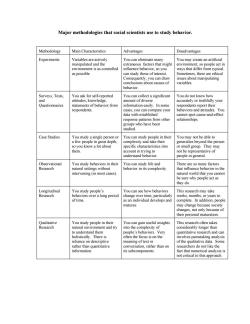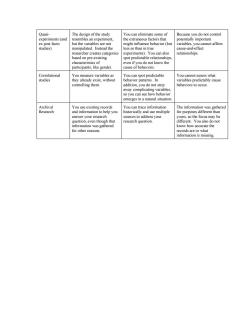《社会科学研究方法》课程教学资源(课堂讨论材料)Major methodologies that social scientists use to study behavior

Major methodologies that social scientists use to study behavior. Methodology Main Characteristics Advantages Disadvantages Experiments Variables are actively You can eliminate many You may create an artificial manipulated and the extraneous factors that might environment,so people act in environment is as controlled influence behavior,so you ways that differ from typical. as possible can study those of interest. Sometimes,there are ethical Consequently,you can draw issues about manipulating conclusions about causes of variables. behavior. Surveys,Tests, You ask for self-reported You can collect a significant You do not know how and attitudes,knowledge, amount of diverse accurately or truthfully your Questionnaires statements of behavior from information easily.In some respondents report their respondents. cases,you can compare your behaviors and attitudes.You data with established cannot spot cause-and-effect response patterns from other relationships. groups who have been studied. Case Studies You study a single person or You can study people in their You may not be able to a few people in great depth, complexity and take their generalize beyond the person so you know a lot about specific characteristics into or small group.They may them. account in trying to not be representative of understand behavior people in general. Observational You study behaviors in their You can study life and There are so many factors Research natural settings without behavior in its complexity. that influence behavior in the intervening (in most cases). natural world that you cannot be sure why people act as they do. Longitudinal You study people's You can see how behaviors This research may take Research behaviors over a long period change over time,particularly weeks,months,or years to of time. as an individual develops and complete.In addition,people matures. may change because society changes,not only because of their personal maturation. Qualitative You study people in their You can gain useful insights This research often takes Research natural environment and try into the complexity of considerably longer than to understand them people's behaviors.Very quantitative research and can holistically.There is often the focus is on the involves painstaking analysis reliance on descriptive meaning of text or of the qualitative data.Some rather than quantitative conversation,rather than on researchers do not like the information. its subcomponents. fact that numerical analysis is not critical to this approach
Major methodologies that social scientists use to study behavior. Methodology Main Characteristics Advantages Disadvantages Experiments Variables are actively manipulated and the environment is as controlled as possible You can eliminate many extraneous factors that might influence behavior, so you can study those of interest. Consequently, you can draw conclusions about causes of behavior. You may create an artificial environment, so people act in ways that differ from typical. Sometimes, there are ethical issues about manipulating variables. Surveys, Tests, and Questionnaires You ask for self-reported attitudes, knowledge, statements of behavior from respondents. You can collect a significant amount of diverse information easily. In some cases, you can compare your data with established response patterns from other groups who have been studied. You do not know how accurately or truthfully your respondents report their behaviors and attitudes. You cannot spot cause-and-effect relationships. Case Studies You study a single person or a few people in great depth, so you know a lot about them. You can study people in their complexity and take their specific characteristics into account in trying to understand behavior. You may not be able to generalize beyond the person or small group. They may not be representative of people in general. Observational Research You study behaviors in their natural settings without intervening (in most cases). You can study life and behavior in its complexity. There are so many factors that influence behavior in the natural world that you cannot be sure why people act as they do. Longitudinal Research You study people’s behaviors over a long period of time. You can see how behaviors change over time, particularly as an individual develops and matures. This research may take weeks, months, or years to complete. In addition, people may change because society changes, not only because of their personal maturation. Qualitative Research You study people in their natural environment and try to understand them holistically. There is reliance on descriptive rather than quantitative information. You can gain useful insights into the complexity of people’s behaviors. Very often the focus is on the meaning of text or conversation, rather than on its subcomponents. This research often takes considerably longer than quantitative research and can involves painstaking analysis of the qualitative data. Some researchers do not like the fact that numerical analysis is not critical to this approach

Quasi- The design of the study You can eliminate some of Because you do not control experiments (and resembles an experiment, the extraneous factors that potentially important ex post facto but the variables are not might influence behavior (but variables,you cannot affirm studies) manipulated.Instead the less so than in true cause-and-effect researcher creates categories experiments).You can also relationships. based on pre-existing spot predictable relationships, characteristics of even if you do not know the participants,like gender. cause of behaviors. Correlational You measure variables as You can spot predictable You cannot assess what studies they already exist,without behavior patterns.In variables predictably cause controlling them. addition,you do not strip behaviors to occur. away complicating variables, so you can see how behavior emerges in a natural situation. Archival You use existing records You can trace information The information was gathered Research and information to help you historically and use multiple for purposes different than answer your research sources to address your yours,so the focus may be question,even though that research question. different.You also do not information was gathered know how accurate the for other reasons. records are or what information is missing
Quasi- experiments (and ex post facto studies) The design of the study resembles an experiment, but the variables are not manipulated. Instead the researcher creates categories based on pre-existing characteristics of participants, like gender. You can eliminate some of the extraneous factors that might influence behavior (but less so than in true experiments). You can also spot predictable relationships, even if you do not know the cause of behaviors. Because you do not control potentially important variables, you cannot affirm cause-and-effect relationships. Correlational studies You measure variables as they already exist, without controlling them. You can spot predictable behavior patterns. In addition, you do not strip away complicating variables, so you can see how behavior emerges in a natural situation. You cannot assess what variables predictably cause behaviors to occur. Archival Research You use existing records and information to help you answer your research question, even though that information was gathered for other reasons. You can trace information historically and use multiple sources to address your research question. The information was gathered for purposes different than yours, so the focus may be different. You also do not know how accurate the records are or what information is missing
按次数下载不扣除下载券;
注册用户24小时内重复下载只扣除一次;
顺序:VIP每日次数-->可用次数-->下载券;
- 《社会科学研究方法》课程教学资源(课堂讨论材料)Concepts That Are Clarified in the Different Sections of a Research Report.docx
- 《社会科学研究方法》课程教学资源(阅读材料)当代中国日常法律工作的意涵变迁(1979—2003).pdf
- 《社会科学研究方法》课程教学资源(阅读材料)Large-Scale Psychological Differences Within China Explained by Rice Versus Wheat Agriculture.pdf
- 《社会科学研究方法》课程教学资源(阅读材料)关键时刻——美国精英眼中的中国、美国与世界.pdf
- 《社会科学研究方法》课程教学资源(阅读材料)谣言传播规律以及对群体事件的影响(燕山大学:赵玉忠、陈业华).pdf
- 《社会科学研究方法》课程教学资源(阅读材料)真的有七年之痒吗——中国夫妻的离婚模式及其变迁趋势研究.pdf
- 《社会科学研究方法》课程教学资源(阅读材料)计算机学报:网络大数据——现状与展望.pdf
- 《社会科学研究方法》课程教学资源(阅读材料)积极心理学对大学生心理健康教育的启示.pdf
- 《社会科学研究方法》课程教学资源(阅读材料)社会转型与工人阶级的再形成.pdf
- 《社会科学研究方法》课程教学资源(阅读材料)社会转型与工人阶级的再形成.pdf
- 《社会科学研究方法》课程教学资源(阅读材料)电影质量与票房相关性分析——基于大众传播学的视角.pdf
- 《社会科学研究方法》课程教学资源(阅读材料)甘肃境内的西南官话——兼论方言形成与区域经济文化的交流(兰州城市学院:莫超).pdf
- 《社会科学研究方法》课程教学资源(阅读材料)涉诉舆论的面相与本相——十大经典案例分析.pdf
- 《社会科学研究方法》课程教学资源(阅读材料)青少年网络犯罪及其治理路径探究.pdf
- 《社会科学研究方法》课程教学资源(阅读材料)方言接触的影响因素研究.pdf
- 《社会科学研究方法》课程教学资源(阅读材料)户口还起作用吗_户籍制度与社会分层和流动.pdf
- 《社会科学研究方法》课程教学资源(阅读材料)我国本科工程教育实践教学问题与原因探析.pdf
- 《社会科学研究方法》课程教学资源(阅读材料)微博兴起背景下大学生思想政治教育的挑战与应对(浙江树人大学:尹晓敏).pdf
- 《社会科学研究方法》课程教学资源(阅读材料)当下历史虚无主义之我见(北京师范大学:郑师渠).pdf
- 《社会科学研究方法》课程教学资源(阅读材料)婚姻质量——度量指标及其影响因素.pdf
- 上海交通大学:《网络环境下的文科信息检索》教学资源(选修课)文献传递与馆际互借——获取文献的最后一根“救命稻草”.pdf
- 《网络环境下的文科信息检索》选修课程教学资源(臺灣師範大學圖書館)杜威十進分類法 Introduction to Dewey Decimal Classification.pdf
- 上海交通大学:《网络环境下的文科信息检索》教学资源(选修课)第10章 国外硕博士论文数据库.pdf
- 上海交通大学:《网络环境下的文科信息检索》教学资源(选修课)第11章 中外法律法规数据库(国内部分).pdf
- 上海交通大学:《网络环境下的文科信息检索》教学资源(选修课)第11章 中外法律法规数据库(HeinOnline法学期刊全文数据库检索指南).pdf
- 上海交通大学:《网络环境下的文科信息检索》教学资源(选修课)第11章 中外法律法规数据库(Lexis Advance快速参考指南).pdf
- 上海交通大学:《网络环境下的文科信息检索》教学资源(选修课)第11章 中外法律法规数据库(全新一代在线法律检索工具——汤森路透Westlaw).pdf
- 上海交通大学:《网络环境下的文科信息检索》教学资源(选修课)第11章 附录(中国台湾地区的法律法规数据库).pdf
- 上海交通大学:《网络环境下的文科信息检索》教学资源(选修课)第12章 统计资料数据库.pdf
- 上海交通大学:《网络环境下的文科信息检索》教学资源(选修课)第13章 国外著名引文索引数据库.pdf
- 上海交通大学:《网络环境下的文科信息检索》教学资源(选修课)第14章 国内引文索引数据库.pdf
- 上海交通大学:《网络环境下的文科信息检索》教学资源(选修课)第15章 其他著名社会科学数据库.pdf
- 上海交通大学:《网络环境下的文科信息检索》教学资源(选修课)第16章 网络搜索引擎.pdf
- 上海交通大学:《网络环境下的文科信息检索》教学资源(选修课)第17章 常用人文社会科学信息资源网站.pdf
- 上海交通大学:《网络环境下的文科信息检索》教学资源(选修课)第1章 信息素养与信息检索概论.pdf
- 上海交通大学:《网络环境下的文科信息检索》教学资源(选修课)第2章 图书馆书目检索系统(陆宏弟).pdf
- 上海交通大学:《网络环境下的文科信息检索》教学资源(选修课)第3章 中文电子期刊数据库.pdf
- 上海交通大学:《网络环境下的文科信息检索》教学资源(选修课)第4章 外文电子期刊数据库.pdf
- 上海交通大学:《网络环境下的文科信息检索》教学资源(选修课)第5章 中文电子图书 第1节 超星数字图书馆.pdf
- 上海交通大学:《网络环境下的文科信息检索》教学资源(选修课)第5章 中文电子图书 第2节 书生之家.pdf
